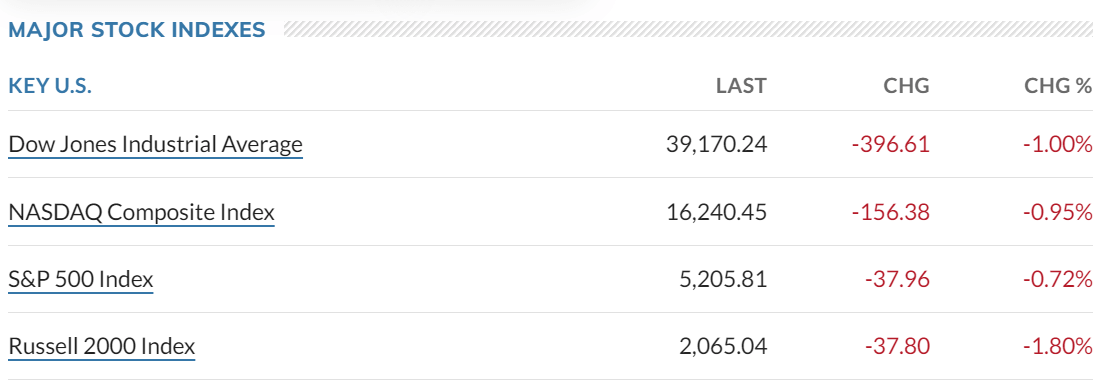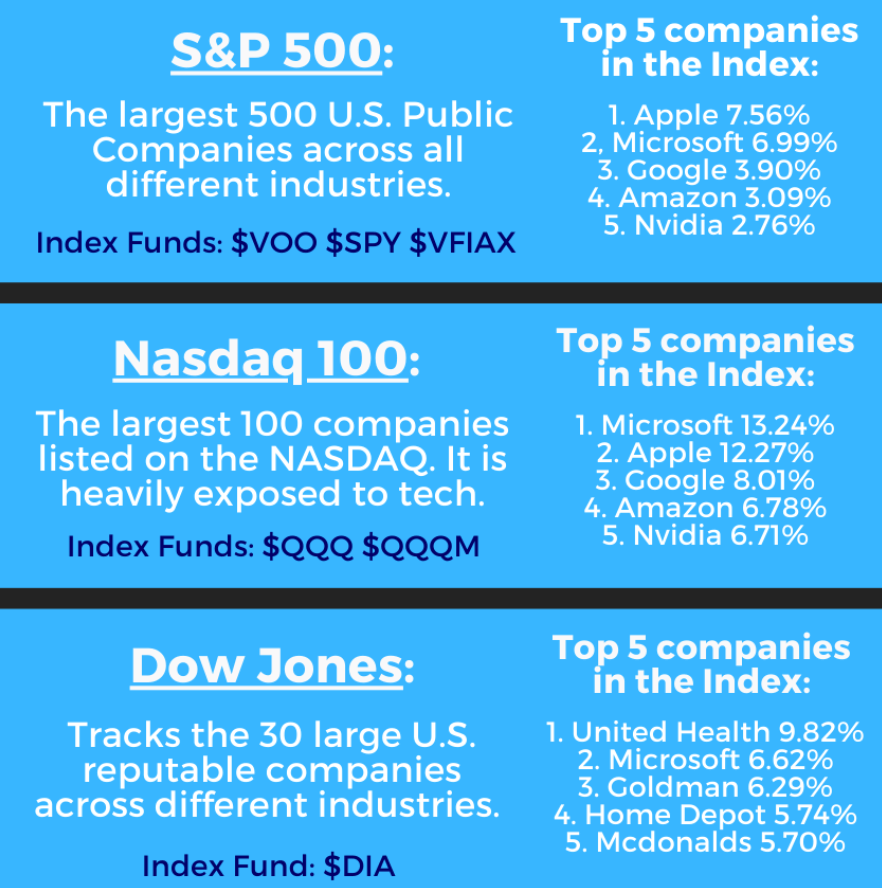As a country with the most developed financial system, the U.S. stock market has always been a favorite place for many international investors. And when it comes to U.S. stocks, it is inevitable to talk about the U.S. stock market index. Generally speaking, as long as there are investment ideas for U.S. stocks, it is unavoidable to study the U.S. stock market indices. Let's take a look specifically at an overview of the U.S. stock indexes and their characteristics that a novice investor must know.
 What are the U.S. stock indices?
What are the U.S. stock indices?
A stock index is an important indicator that describes changes in the overall price level of the stock market and provides a better measure of market fundamentals than the volatility of individual stocks. The U.S. stock indices are important indicators that reflect the overall situation of the U.S. stock market. Investors can learn about U.S. stock market trends and market conditions by observing these indices.
In the U.S. stock market, the three most commonly used indices are the Dow Jones, S&P, and NASDAQ. Among them, the most famous Dow Jones index is the dow jones industrial average, abbreviated as DJIA, which was created by Charles Dow Jones, the founder of Dow Jones Publishing, in 1885 and is one of the oldest and most famous stock indexes in the U.S. stock market.
The DJIA consists of the stocks of 30 large U.S. companies and is widely recognized as an important indicator of the U.S. stock market and one of the most representative indices of the global stock market. It covers representative companies from a variety of sectors, including industrial, financial, and technology, and is therefore seen as an indicator of the overall health of the U.S. economy.
There is also the Dow Jones Transportation Average, which contains the stocks of 20 companies in the transportation industry, such as airlines, railroads, shipping, etc., and is seen as one of the leading indicators of the state of economic transportation. The Dow Jones Utility Average, on the other hand, contains stocks of 15 utility companies, such as electricity, natural gas, water, etc., and is used to reflect the overall performance of the utility industry.
The Dow Jones Composite Indexes contain a combination of the Dow Jones Industrial Average, the Dow Jones Transportation Average, and the Dow Jones Utility Average and represent the broad performance of the U.S. stock market. At the same time, Dow Jones also compiles a series of indexes covering different U.S. markets and sectors, such as the Dow Jones U.S. Large Cap Index and the Dow Jones U.S. Small Cap Index.
The S&P indices, on the other hand, are a series of stock indices compiled by Standard & Poor's Global Ratings Services, the most famous of which is the S&P 500 Index, which covers the stocks of 500 large publicly traded companies in the United States. The S&P 500 is one of the most important stock indices in the world and one of the most representative indices of the U.S. stock market, and it is widely used to track the overall performance of the U.S. stock market.
The S&P 100 Index, known as the "Blue Chip Index," is comprised of the 100 largest publicly traded companies in the United States and includes a subset of the S&P 500 Index. The S&P 1500 Index consists of the S&P 500 Index, the S&P MidCap 600 Index, and the S&P SmallCap 400 Index, covering large, medium, and small companies in the U.S. stock market.
The Nasdaq Indexes are a series of stock indexes compiled by the Nasdaq Stock Market, which includes the Nasdaq Composite Index and the Nasdaq 100 Index. The Nasdaq Composite Index covers all stocks listed on the Nasdaq exchange, while the Nasdaq 100 Index includes the stocks of the 100 largest non-financial companies, primarily technology companies, on the Nasdaq exchange.
The NASDAQ Biotechnology Index, on the other hand, tracks the performance of the biotechnology sector and contains stocks of biotechnology companies listed on the NASDAQ exchange. The NASDAQ Bank Index, on the other hand, tracks the performance of the banking industry and contains stocks of banks and financial services companies listed on the NASDAQ exchange.
The Nasdaq Computer Index tracks the performance of the computer technology industry and includes stocks of computer hardware, software, and service companies listed on the Nasdaq exchange. The NASDAQ Internet Index, on the other hand, tracks the performance of the Internet and e-commerce industry and contains stocks of Internet and e-commerce companies listed on the NASDAQ exchange.
In addition to this, there are many other important U.S. stock indices, such as the New York Stock Exchange Index, the Russell 2000 Index, the Philadelphia Semiconductor Index, and many others. There are a number of other important indices that, although they may not be as well known as the first three, are important in specific sectors or in specific markets. Examples include the Dow Jones Transportation Average, the Wilshire 5000, the NASDAQ 100, and so on.
 Which U.S. Stock Indices to Watch
Which U.S. Stock Indices to Watch
While there are many U.S. stock indexes, each of these indexes has its own characteristics and importance, and investors need to choose to focus on one or more of them based on their preferences and investment strategies. In fact, this needs to be viewed in terms of investment objectives, risk appetite, and investment strategy.
Take the three major U.S. stock indices, the Dow Jones Industrial Average, the S&P 500, and the Nasdaq Composite, for example. These three indices collectively represent stocks of different industries and sizes in the U.S. stock market, providing investors with important market references and investment choices. At the same time, they each have unique characteristics and importance that are suitable for different types of investors and investment strategies.
The Dow Jones Industrial Average, abbreviated as DJIA, consists of 30 well-known large U.S. companies with relatively stable constituents and covers a wide range of industrial sectors, including industrial, financial, energy, etc. It represents the overall condition of the U.S. economy and is the most credible index reflecting the development of U.S. industry.
As one of the oldest and most famous stock indices in the U.S. stock market, DJIA is widely recognized as the barometer of the U.S. stock market. The companies it covers are mostly established companies with relatively stable profitability and market positions. It is also calculated using a price-weighted average, and through continuous adjustment and optimization, it is able to more accurately reflect the situation of the stock market in the industrial sector. Although there are only 30 constituent stocks, they are widely followed by investors because of their long history.
For investors who are just beginning to understand the stock market, the Dow Jones Industrial Average is a good starting point. Since it contains some well-known and long-established companies, tracking the index can be a great way for beginners to help them understand the fundamentals of the market and how it works more easily.
Compared to some other U.S. stock indexes, the Dow Jones Industrials has relatively low volatility. Because it contains only 30 companies and most of these companies are well-established, stable businesses, it is a bit less risky than some of the indexes that contain more companies.
And because Dow Jones Industrials represents major companies from all sectors of the U.S. economy, for long-term investors, the index can provide an overall reference to market performance to help them make decisions over the long term. That said, the Dow Jones Industrials are suitable for many types of investors.
The S&P 500 Index (S&P 500), created and maintained by Standard & Poor's in 1967, contains the stocks of 500 large publicly traded companies in the U.S., covering a wider range of markets. The industries and companies covered are more comprehensive and include a wide range of sectors such as industrial, technology, healthcare, and financials. Compared to the 30 constituents of the Dow Jones Index, the S&P 500 Index diversifies more risk and is able to reflect market changes more broadly.
Moreover, the constituent stocks have strict regulations, such as top 500 Market Capitalization and four consecutive quarters of positive surplus, and are calculated using market capitalization weighting. It is considered to be an important representative of the U.S. stock market and can provide a quick overview of the overall U.S. stock market trend. In addition, the importance of the S&P 500 has been recognized by the SEC, and in recent years, it has even become the calculation standard for the U.S. meltdown mechanism.
For investors who are just starting to understand the stock market, the S&P 500 is a good starting point. Investors can track the S&P 500 index to understand the overall trend of the market and industry distribution, helping to build investment ideas and risk awareness. It also provides a relatively stable return over time for long-term investors since the index represents a broad spectrum of the U.S. economy, covering large companies in a variety of industries.
And it's also popular with passive investors, who tend to avoid frequent buying and selling operations, opting instead to hold stocks for the long term to track the overall performance of the market. By investing in S&P 500 index funds or ETFs (exchange-traded funds), passive investors can gain access to a broadly diversified portfolio and track the performance of the market at a lower cost.
The NASDAQ Composite Index is a stock index compiled by the NASDAQ Stock Market that includes all common stocks listed on the NASDAQ exchange. There are approximately 3,000 companies, and the constituents have strict requirements in terms of listing and market capitalization, which are also calculated using market capitalization weighting.
As a composite index, the NASDAQ Composite Index covers companies of all industries and sizes, including emerging industries such as technology, the internet, biotechnology, and growth companies, and is therefore widely used to measure the U.S. stock market as a whole. Compared to NYSE listings, Nasdaq listings are more liberal and therefore cover many startups and technology companies.
It is also known as the Technology Stock Index for this reason, reflecting the transformation of the US economy into a high-tech industry. It is therefore attractive to investors seeking high risk and high return. However, because it contains many tech companies and growth stocks, it can also carry a high degree of volatility.
The NASDAQ Composite Index may have high volatility as it contains many growth stocks. For investors willing to take risks and seek high returns, the NASDAQ Composite Index offers an investment opportunity that covers a broad range of technology and growth sectors.
Overall, investors who are beginners or prefer lower risk may be more inclined to look at the Dow Jones Industrial Average or the S&P 500. Those seeking higher risk, a higher return, or who are interested in technology and growth companies may be more inclined to look at the Nasdaq Composite Index. Of course, in addition to investing directly in U.S. stock indexes, investors can get similar investment returns by investing in U.S. stock index funds.

U.S. Stock Index Fund
It is an investment vehicle designed to track specific U.S. stock indices, such as the Dow Jones Industrial Average, S&P 500, and Nasdaq Composite. These funds replicate the performance of the index by holding the constituent stocks and allocating assets according to the weights of the particular index. As a result, their investment strategies are usually passive and do not require frequent buying and selling operations.
U.S. equity index funds cover a variety of different types of indexes, including broad market indexes (e.g., S&P 500, Dow Jones Industrial Average), sectoral indexes (e.g., technology, financials, healthcare), and size indexes (e.g., NASDAQ 100, Russell 2000).
Since U.S. index funds are designed to track the performance of market indices, they are suitable for long-term investors who can hold them for a long period of time and gain long-term growth in the market as a whole. Compared to actively managed funds, U.S. equity index funds typically have lower management fees and transaction costs. Their fees are more reasonable, which allows investors to access market performance at a lower cost.
These funds track a specific equity index by holding index constituent stocks, so investors can buy a fund to gain broad diversification into an entire market or a specific sector, thereby reducing the risk of a single stock or industry.
The portfolios of U.S. index funds are usually publicly available and transparent, and investors can readily access information about the fund's holdings as well as the fund's net asset value and net value per share. As exchange-traded or index funds, U.S. index funds can be traded like stocks, and investors can buy and sell them at any time during the trading day, providing a high degree of liquidity.
To invest in U.S. index funds, purchasing the corresponding ETFs in the secondary trading market is a common way to gain exposure to a specific index. Investors can choose a suitable ETF based on their investment objectives, risk appetite, and market expectations. e.g., if investors want to get the returns of large-cap U.S. stocks, they can choose an ETF that tracks the S&P 500 Index; if they want to focus on the technology sector, they can choose an ETF that tracks the NASDAQ 100 Index.
To summarize, a U.S. stock index fund is a simple, low-cost, diversified, and highly liquid investment tool that is suitable for the majority of investors to make long-term investments or short-term trading in the U.S. stock market. By choosing an index fund that suits their investment objectives and risk appetite, investors can better realize portfolio diversification and risk management.
List of U.S. stock indexes for 2024
| U.S. equity index funds |
Asset management scale |
ETF Prices |
Cost ratio |
Number of Holdings |
5-year average annualized return |
dividend yield |
| SPLG |
$25 billion |
$55.49 |
0.02% |
503 |
12.60% |
1.40% |
| RSP |
$48 billion |
$156.41 |
0.20% |
504 |
10% |
1.80% |
| SCHD |
$51 billion |
$75.45 |
0.06% |
104 |
10.60% |
3.70% |
| QQQE |
$911 million |
$83.63 |
0.35% |
101 |
13.70% |
0.80% |
| ACWX |
$4.5 billion |
$50.39 |
0.34% |
1,894 |
2.30% |
2.50% |
| IJH |
$77 billion |
$274.59 |
0.05% |
405 |
6% |
1.60% |
| COWZ |
$17 billion |
$52.09 |
0.49% |
100 |
12.30% |
2.20% |
| IMCV |
$593 million |
$67.69 |
0.06% |
310 |
5% |
2.60% |
| PRFZ |
$2 billion |
$36.83 |
0.39% |
1,450 |
7% |
1.20% |
| AGG |
$99 billion |
$98.68 |
0.03% |
11,282 |
0.08% |
4.30% |
Disclaimer: This material is for general information purposes only and is not intended as (and should not be considered to be) financial, investment, or other advice on which reliance should be placed. No opinion given in the material constitutes a recommendation by EBC or the author that any particular investment, security, transaction, or investment strategy is suitable for any specific person.



 What are the U.S. stock indices?
What are the U.S. stock indices? Which U.S. Stock Indices to Watch
Which U.S. Stock Indices to Watch























